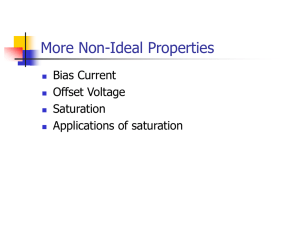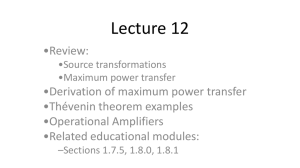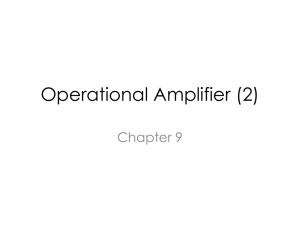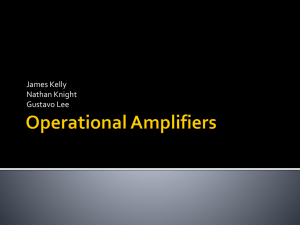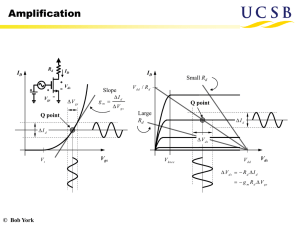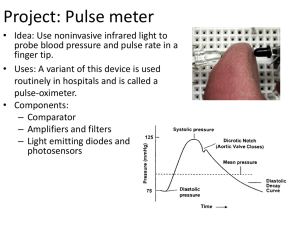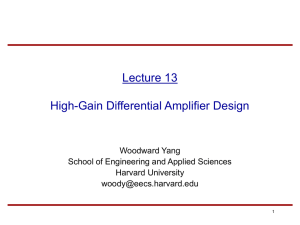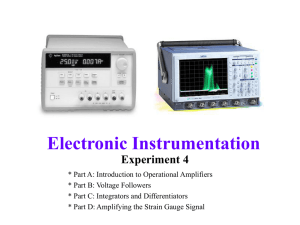Op Amp History
advertisement
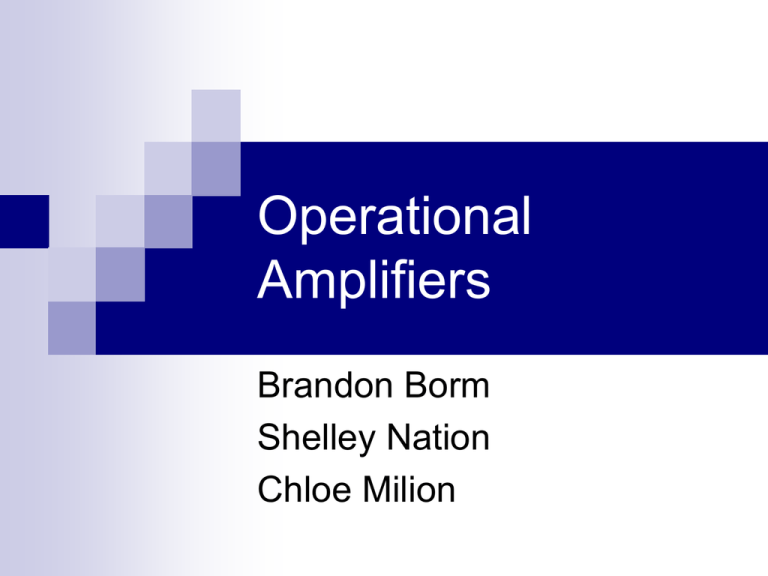
Operational Amplifiers Brandon Borm Shelley Nation Chloe Milion Outline Introduction Background Fundamentals of Op-Amps Real vs. Ideal Applications What is an Op-Amp Low cost integrating circuit consisting of transistors resistors capacitors Op-amps amplify an input signal using an external power supply Uses for Op-Amps Op-Amps are commonly used for both linear and nonlinear applications Linear Amplifiers Summers Integrators Differentiators Filters (High, Low, and Band Pass) Non-linear Comparators A/D converters Vacuum Tube Op-Amps First op amps built in 1930’s1940’s Technically feedback amplifiers due to only having one useable input Used in WWII to help how to strike military targets Buffers, summers, differentiators, inverters Took ±300V to ± 100V to power http://en.wikipedia.org/wiki/Image:K2-w_vaccuum_tube_op-amp.jpg1 Solid State Discrete Op-Amps Solid state op amps invented in 1960’s Possible due to invention of silicon transistors and the IC Chip and discrete parts Reduced power input to ±15V to ±10V Packaging in small black boxes allowed for integration with a circuit Monolithic Integrated Circuit Op-Amp First created in 1963 μA702 by Fairchild Semiconductor μA741 created in 1968 Became widely used due to its ease of use 8 pin, dual in-line package (DIP) Further advancements include use of field effects transistors (FET), greater precision, faster response, and smaller packaging Features of Op-Amps +Vin: non-inverting input -Vin: inverting input +Vs: positive source -Vs: negative source Vout: output voltage ON: Offset Null NC: Not Connected +Vin +Vs + Vout -Vin - -Vs ON -Vin NC +Vs +Vin Vout -Vs ON Characteristics of Op-Amps Ideal Op-Amp Infinite open loop gain (GOL): Zero Real Op-Amp Decreases with increase in frequency Non-zero common mode gain common mode gain Infinite bandwidth: Range of frequencies with non-zero gain Limited open loop gain: Limited Bandwidth: Gain becomes zero at high frequencies Characteristics of Op-Amps Ideal Op-Amp Real Op-Amp Infinite slew rate Finite slew rate Infinite input impedance Large input impedance No Small input current Zero output impedance Infinite output current input current Non-zero output impedance Limited output current Summary of Characteristics Parameter Ideal Op-Amp Typical Op-Amp GOL ∞ 105 - 109 Common Mode Gain 0 10-5 Bandwidth ∞ 1-20 MHz Input Impedance ∞ Output Impedance 0 106 Ω (bipolar) 109-1012 Ω (FET) 100-1000 Ω Ideal Op-Amp Active device Infinite open loop gain Infinite input impedance Zero output impedance +Vs iin = 0A + Vdiff Vout = Vdiff x Gopenloop -Vs Negative Feedback Vout is a linear function of the input voltage Zin = infinity Modelisation of basic mathematical operation Iin=0A Vdiff=0V Non Inverting Circuit iin = 0A Vin +Vs (1) V- - Vout = R2 x i + Vout Vdiff = 0V 0A R1 V- = V+ = Vin -Vs i (2) i = -Vin/R1 R2 (1) V- (2) V- = - R1 x i Vin – Vout = -Vin x R1/R2 V- - Vout Vout = (1 + R1/R2) x Vin Inverting Circuit +Vs iin = 0A (1) V- - Vout = R2 x i + Vout Vdiff = 0V (2) Vin - V- = R1 x i -Vs Vin R1 Vin – V- i R2 V- - Vout V- = V+ = 0 (1) i = Vin / R1 Vout = - R2/R1 x Vin Follower Circuit + Vs Vin Vout - Vs Summing Op-Amp • Adds analog signals Ohm’s Law: Solving for Vout: V1 V V2 V V3 V V Vout R1 R2 R3 Rf Vout V1 V2 V3 R f R1 R2 R3 Summing Op-Amp Difference Op-Amps • Subtracts analog signals • Output voltage is proportional to difference between input voltages: Vout R3 R1 R4 V R3 V1 2 ( R4 R2 ) R1 R1 Difference Op-Amp Integrator Op-Amps •Similar layout to inverting op-amp, but replace feedback resistor with a capacitor •A constant input signal generates a certain rate of change in output voltage • Smoothes signals over time •Output voltage is proportional to the integral of the input voltage: t 1 Vout , final Vout ,initial Vindt RC 0 Integrator Op-Amp Differentiating Op-Amp •Similar to inverting op-amp, but input resistor is replaced with a capacitor •Accentuates noise over time • Output signal is scaled derivative of input signal: Vout dVin RC dt Differentiating Op-Amp Active Filters Different types of active filters: Low Pass Filters out frequencies above a cutoff frequency High Filters out frequencies below a cutoff frequency Band Pass Pass Passes a range of frequencies between two cutoff frequencies Active Low-Pass Filter Cutoff frequency: 1 c R2C Active High-Pass Filter Switch positioning of capacitors and resistors from lowpass filter locations to create high-pass filter. Active Band-Pass Filter Created by connecting output of a highpass filter to the input of a low-pass filter or vice versa. Also can create using only 1 op-amp with feedback and input capacitors No negative feedback Vout is a non-linear function of the differential input voltage V+ - V- V+ - V- = Vdiff Vout = sign(Vdiff) x Vs Binary logic and oscillator Comparator Vout ( volts ) +Vs iin = 0A + Vout Vdiff + Vs - V+ Vdiff 0V V- -Vs - Vs Comparator Questions? References “Operational Amplifiers.” http://en.wikipedia.org/wiki/Op_amp “Real vs. Ideal Op Amp.” http://hyperphysics.phyastr.gsu.edu/hbase/electronic/opamp.html#c4 “741 Op Amp Tutorial.” http://www.uoguelph.ca/~antoon/gadgets/741/74 1.html “Op Amp History.” Analog Devices. http://www.analog.com/library/analogDialogue/ar chives/39-05/Web_ChH_final.pdf

